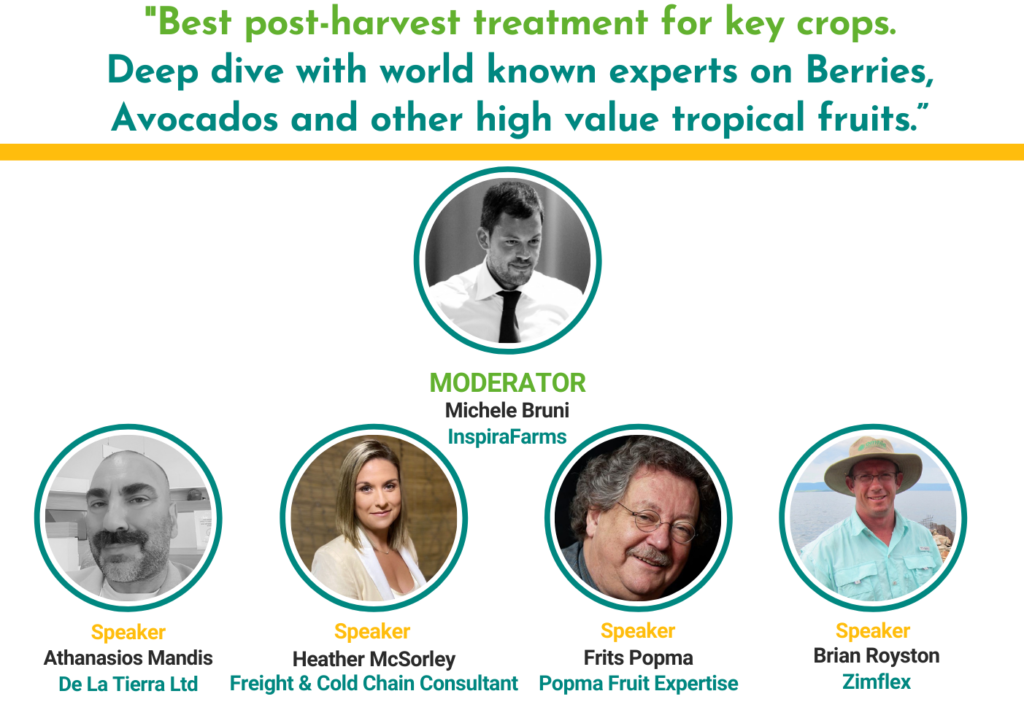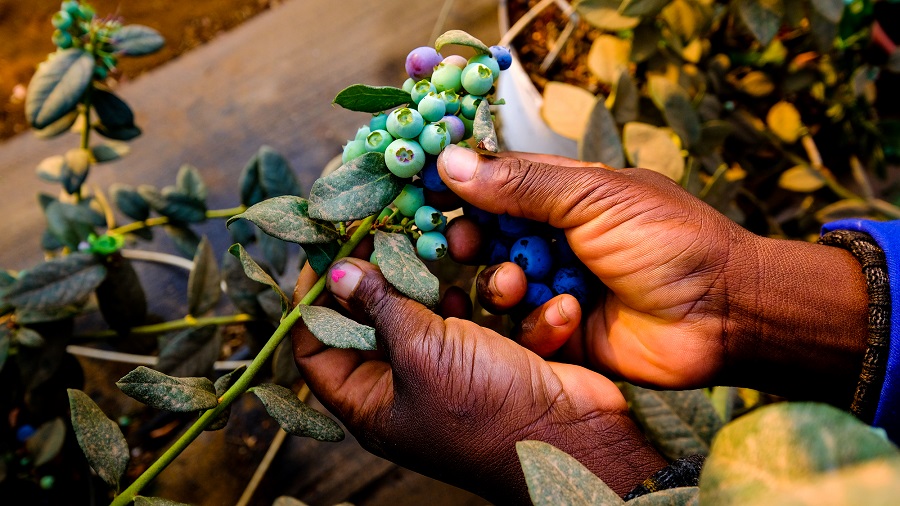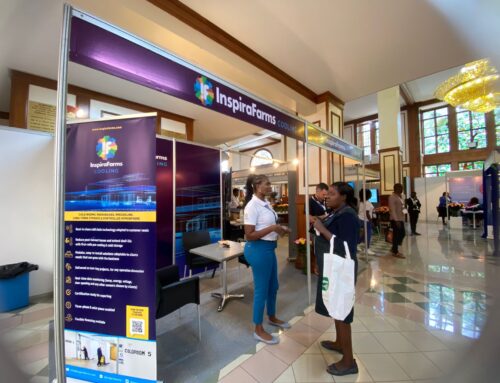Key take-outs of the webinar: Best post-harvest treatment for key crops
Our webinar, “best post-harvest treatment for key crops, a deep dive with world known experts on berries, avocados and other high value tropical fruits,” brought together speakers in the industry, Postharvest expert (De la Terra), UK, Athanasios Mandis, Cold chain and freight expert, Zimbabwe, Heather McSorley, Popma Fruit Expertise, Netherlands, Frits Popma, Zimflex, Zimbabwe, Brian Royston and a special guest Ernest Muthomi, CEO (Chief Executive Officer) of the Avocado Society of Kenya (ASK). The webinar was led and moderated by Chief Commercial Officer, Michele Bruni from InspiraFarms.

The objective of the webinar was to establish the most shared challenges around post-harvest management of high value export crops. At the same time, present good practices and the adoption of appropriate and novel postharvest technologies that assure the most favourable conditions to extend storage life, retain quality and nutritional attributes of the fruit through the following topics:
Cold Chain
The cold chain is an incredibly significant tool that helps in post-harvest management for high value crops. Starting a cold chain as soon as possible and maintaining it is critical. Heather started us off by saying that with the right cold chain facilities and maintenance, one is guaranteed easy access to markets, movement from air freight to ocean freight, reduced losses and rejections on arrival at final markets.
“A lot of growers are investing in units that are circulating air that’s colder than they need in hope of reducing the temperature in the room to speed up the cooling cycle. It is critical to get it right from the beginning. Removing that field heat, packing your product, getting your final temperature drop, and then hitting that supply chain and making sure you’re giving your product the best possible chance of arrival in excellent quality,” she stated.
Brian reiterated this by stating that, getting the right cold chain and logistics in place will ensure that the quality of the crops remains top-notch. He also stated that having the right genetics, working with the right growers and marketing agents is key to stay relevant in the market. He emphasized on the need to understand the backend of production and the creation of space in the cold chain facilities.
“There is not enough time spent on process flows, culture and the exact requirements during each stage of that chain. Space is also a big challenge as designers of these facilities are not creating space to work, move, carry and pull skits through that will enable understanding of your cold chain to get the cooling parameters right,” says Brian.
Atha concluded by saying that a lack of awareness and consideration of your supply chain will have repercussions much further down the line and therefore, it is critical to be aware of that full supply chain.
Temperature
Berries and avocados experience different challenges and expectations when it comes to packing and temperature. For berries, Brian states that one must pack and cater for dehydration along the route.
“Depending on the route being taken, we try to pack between 5% and 7% additional fruit into a punnet to take care of dehydration. If we can take that level from 3% down to 1% with the humidifiers and forced air coolers, over a 28-day (about 4 weeks) project, that is $25,000 to $30,000 that you have put back onto the bottom line. So, there is a big opportunity there and we need to take it seriously,” says Brian.
With berries coming in with as high as 45 degrees of field heat, Heather suggests that the goal for berries is to reduce the pulp temperature as quickly as possible to get an extended shelf life.
“By using inefficient cooling, you can achieve the temperature results, however, you will end up making a great loss to your shelf life. Understanding how important the step-down temperature controls are for berries impacts your quality, your shelf life, access to markets and mode of exportation,” she echoed.
Temperature control also comes as a challenge as the vehicle for removing heat is moisture as said by Atha. When talking about temperature control, one needs to be mindful of relative humidity. If the room in which it is placed has low relative humidity, then the drive for temperature becomes too steep.
“The risk of losing too much moisture not only represents loss in cash value but also increases the exposure to secondary infection,” he says.
As for avocados, having an understanding on when to harvest is fundamental and should neither be too early, nor too late. Avocados should also not be stressed by the temperatures. One should ensure that the pallets are all kept under the same temperature with the right amount of pressure being removed. Storing the pallets below the evaporators in cold storage units should be avoided at all costs as it generates a system failure where there is risk of the compressor breaking.
Avocados have different minimum dry content and are a unique fruit since they do not ripen on trees. Due to this, there may be a benefit of allowing them to stay on the tree longer, rather than trying to extend post-harvest as compared to berries and other delicate tropical fruits.
Frits lastly stated that the problem he has witnessed is that buyers purchase without any risks in mind. This then forces the producer to harvest their fruits prematurely and later affecting the end consumer.
Design and Data.
When you are considering your infrastructure, there is a lot to think about other than degrees and relative humidity according to Heather.
You would want to consider your farm activity, your production, the number of people you have packing, the volumes you going to be delivering and understanding the first step of the temperature protocol, which is removing field heat.
“You have to think about how many people you’ve got packing and how much they can pack in an hour. Is that matching your delivery from field? Are you achieving your output volumes to match your market? So considering body temperature in your pack room is important to make sure that you are maintaining that step down,” added Heather.
Data on the other hand can indicate how you need to best manage your product. For instance, when using a cold room or packhouse and temperatures are not right for the crop, the alarm will tend to go off signaling an abuse in temperature and will prompt you to move that specific batch first to assign a longer shelf life.
“From an exporter perspective knowing or having evidence that there has been temperature abuse during transit allows you to make sure that a claim is placed against the shipper rather than yourself. From a financial perspective, having that data gives you traceability on your product and its managements which provides you the necessary protection by insurance,” Atha restated.
It was concluded that using data loggers for your entire transit keeps everyone accountable as the producers spend a lot of time, making sure that they produced A grade quality fruits.
Stay up-to-date by signing up to our newsletter here and look out for our next webinar that will take place in July.



